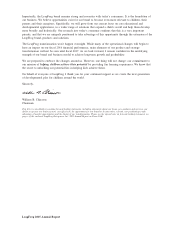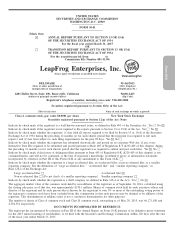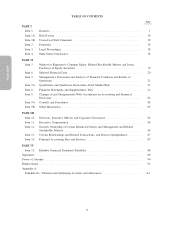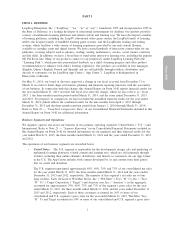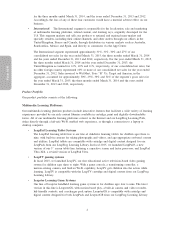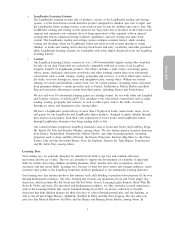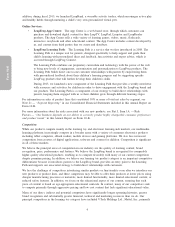LeapFrog 2015 Annual Report Download - page 12
Download and view the complete annual report
Please find page 12 of the 2015 LeapFrog annual report below. You can navigate through the pages in the report by either clicking on the pages listed below, or by using the keyword search tool below to find specific information within the annual report.
under its Fisher-Price brand, and Hasbro, Inc. and its Playskool division. The primary competitors for our
multimedia learning products are kid-targeted tablets from Fuhu and VTech and, to a lesser extent, general
tablet computers and eBook readers from Apple, Amazon and Samsung, and the Sony and Nintendo handheld
gaming systems. For information on how competition could affect our business, see Part I, Item 1A. — Risk
Factors — ‘‘If we are unable to compete effectively with existing or new competitors, our sales and market
share could decline.’’
Our products also compete for the leisure time of children and the discretionary spending of parents with
other forms of media and entertainment. We design our products to bring fun to learning in order to compete
favorably with these outside competitive influences.
Manufacturing
We are committed to designing and manufacturing products that meet or exceed applicable safety and
regulatory requirements. As is the case with the overwhelming majority of toy brands and most consumer
electronics companies, most of our products are manufactured in China. We actively manage our supplier
base, mandating compliance with U.S. and international safety inspections and enforcing our product
standards. Our standards require that we meet or exceed all applicable regulatory requirements regarding
safety in the design, manufacture, packaging, and delivery into the hands of each product’s ultimate user, a
child. Our quality control system processes include product testing and verification for safety and reliability,
starting in the design phase of a product’s life cycle and continuing through production and field support. For
more information about the adverse effects that could result from possible errors or defects in our products,
see Part I, Item 1A. — Risk Factors — ‘‘Any defects contained in our products, or our failure to comply with
applicable safety standards, could result in recalls, delayed shipments, rejection of our products, product
liability and damage to our reputation, and could expose us to litigation or regulatory action.’’
Our manufacturing and operations strategy is designed to maximize the use of outsourced services,
particularly with respect to the actual production and physical distribution of our products. We outsource
substantially all of our manufacturing using several Asia-based manufacturers, most of which manufacture our
products at facilities in the Guangdong province in the southeastern region of China. These manufacturers are
selected based on their technical and production capabilities and are matched to particular products to achieve
cost and quality efficiencies. We depend on these manufacturers to produce sufficient volumes of our finished
products in a timely fashion, at satisfactory cost and quality levels, and in accordance with our and our
customers’ terms of engagement. Labor costs in China continue to increase due to a variety of factors. For
information on the potential business risk resulting from our reliance on contract manufacturers, see Part I,
Item 1A. — Risk Factors — ‘‘Our reliance on a limited number of third-party manufacturers to produce the
majority of our products presents risks to our business.’’
We have established subsidiaries in Hong Kong and Shenzhen, China to work closely with our contract
manufacturing service providers. These subsidiaries manage product design, the supply of raw materials, labor
and the assembly process.
Most of our products are manufactured from basic raw materials such as plastic and paper, and a majority
of our products require electronic components. These raw materials are readily available from a variety of
sources, but may be subject to significant price fluctuations. Some of the electronic components used to make
our products, including our application-specific integrated circuits, currently come from single suppliers. For
information as to how this concentration of suppliers could affect our business, see Part I, Item 1A. — Risk
Factors — ‘‘Significant increases in the cost of our components and raw materials or an inability to obtain
these in suffıcient quantities from our suppliers or alternative sources could negatively impact our financial
results.’’
Research and Development
We design our multimedia learning platforms and related content, learning toys, and online services using a
combination of in-house research and development (‘‘R&D’’) resources and outside consultants. Generally,
once the design phase of the product is complete, the remaining development and manufacturing of the
products are outsourced to third parties. Our total R&D expense was $36.0 million, $9.1 million,
5




